Understanding Diamond Depth And Table Percentages
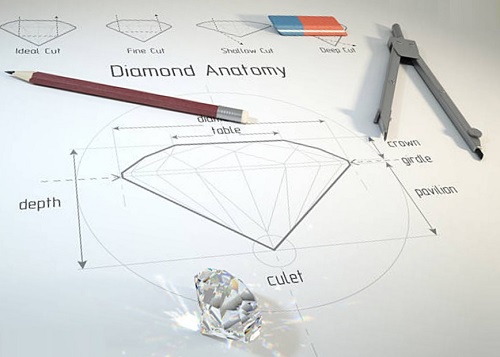
The depth and table size of a diamond can have a big impact on its appearance and light performance.
In this write up, you are going to find out how these 2 factors affect the diamond’s overall cut quality. I will also reveal the recommended table and depth proportions to look out for if you want to buy a diamond with better brilliance and sparkle.
Let’s dive in…
This is the list of topics we will be covering here:
- What is the Depth of a Diamond And What It Means?
- How Extreme Depth Proportions Can Negatively Affect Sparkle
- What is the Table of a Diamond And What It Means?
- The Importance of Table Size And Percentages
- What Are the Best Depth And Table For Diamonds?
- How to Use Depth And Table Percentages Effectively
What is the Depth of a Diamond And What It Means?
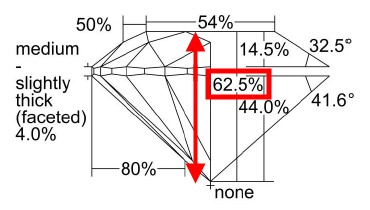
Where to find the depth percentage values in the certificate.
The depth of a diamond is its height (in millimeters) measured from the culet to the table.
In a grading report, there are normally two measurements of depth – the first is the actual depth measurement in millimeters (shown under ‘measurements’ at the top of a grading report), and the second is the depth percentage (see image above), which shows how deep the diamond is in relation to its width.
The craft of polishing a diamond is both an art and science. When light rays enter a diamond, the depth of a diamond affects how the light rays will travel and be reflected within it.
To create optimal light return and sparkle, the ideal depth percentage of a diamond would depend on its shape and may vary based on the intricate relationship with other facets (more details about this later).
How Extreme Depth Proportions Can Negatively Affect Sparkle
Even though the depth percentage of a diamond doesn’t tell the entire story about its appearance, it can be used as a telltale sign for brilliance and value (stones that are cut too deeply are usually cut to retain weight from the rough).
The pavilion facets, in particular, should be cut to correct proportions so that light rays can bounce around within the diamond and be reflected out at the proper angle to the observer’s eye.
Dark looking nailheads and unsightly fish-eye effects are undesired consequences of bad depth proportions. Below are 2 such examples where things get really wonky when diamond depth is too deep or too shallow.
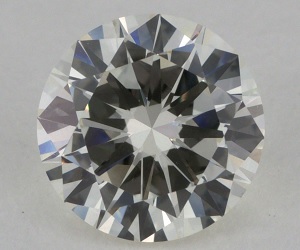
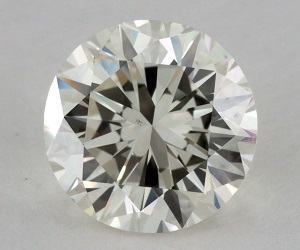
Total depth percentages of 56.6% (left) and 65.9 (right) are recipes for disastrous looks.
As I mentioned earlier, the ideal depth percentage varies with the shape of the diamond. A depth percentage that may be too deep for one shape might be essential for another due to the intrinsic behavior of the facet structure.
For instance, a princess cut with a 74 or 76 percent depth would still be considered acceptable and can yield an attractive diamond. On the other hand, a depth of 65 percent for a round diamond would be excessive and be detrimental to its beauty.
What is the Table of a Diamond And What It Means?
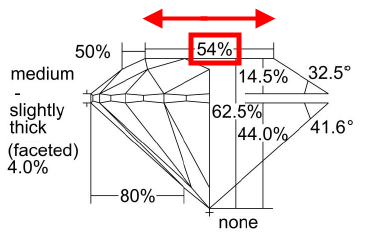
Where can you find the table size percentage? (FYI, this diamond has a 54% table).
The table refers to the flat facet of the diamond which can be seen when the stone is face up. It also happens to be the largest facet on a diamond and plays a vital role in the brilliance of the stone.
In a grading report, table percentage is calculated based on the size of the table divided by the average girdle diameter of the diamond. So, a 60 percent table means that the table is 60 percent as wide as the diamond’s outline.
If a diamond is round cut, gemologists can compute this value by dividing the table diameter, measured in millimeters by the average girdle diameter. For a consumer, this can easily be calculated based on the average physical measurements found in a grading report’s top left-hand side.
For fancy shaped diamonds, table percentage is computed by dividing the table width (measured at the widest part of the facet) by the width of the widest part of the stone measured in millimeters.
The Importance of Table Size And Percentages
The main purpose of the table facet is to refract light rays entering the diamond and to redirect reflected light rays from the pavilion facets back into the observer’s eye.
It is widely misconceived that a larger table percentage would make a round diamond more brilliant than one with a smaller table. This is not true because there are other factors that contribute to the overall brilliance and fire of a diamond.
In short, a bigger table doesn’t mean better looks and vice versa. However, the size of the table can affect the fire dispersion properties of a diamond. Why?
To answer that question, you need to understand that fire is best observed at the bezel facets of a diamond. With a finite amount of space at the crown area, having a larger table would mean that bezel and upper girdle facets would now have less surface area and hence, dispersion decreases.
Vice versa, having a small table would allow girdle facets to disperse light more effectively while suffering from issues with brilliance. It is therefore important to strike a balance between light transmission through the table and color dispersion through the crown and upper girdle facets.

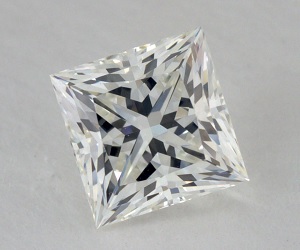
An insanely huge table of 81% will make the stone on the left devoid of dispersion properties.
What Are the Best Depth And Table For Diamonds?
Here’s a chart of recommended depth and table percentages that I personally use when shopping for high-performance diamonds. I’ve only listed the most popular shapes to keep things simple.
For round cut diamonds, I always look for a table between 54% to 57% and a depth between 61% and 62.5%. Besides table and depth proportions, I also follow a list of ideal proportions in crown and pavilion angles here.

Using the recommended table and depth percentages above, you can easily rule out diamonds that aren’t well cut. This will enable you to quickly narrow down your choices and help you to avoid low quality stones during your search.
If the shape you want to buy isn’t found above, use the navigation menu in the header and click on the respective link. This will bring you to the corresponding section with comprehensive information on the different diamond shapes.
How to Use Depth And Table Percentages Effectively
Sleek pave engagement ring with super ideal cut diamond – WF
Combined, the depth and table percentages of a diamond play a major role in the stone’s beauty. It shows you how the stone has been cut in relation to its proportions and they are the first few values to help you instantly weed out diamonds with less ideal cuts.
While the variations in brilliance and sparkle may be apparent to the eye, the subtleties of proportioning may not be easy to discern. Bear in mind that the numbers and percentages are meant to be used as a guideline and a filtering tool.
Even if a diamond has values that lie within “ideal” ranges, you would still require additional performance data like videos and ASET imagery to determine its cut precision. For a step by step guide to selecting a diamond correctly, you should refer to this guide here.
Related Articles
Leave A Comment

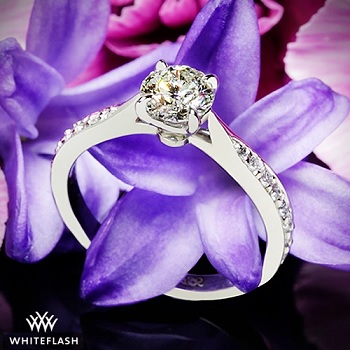
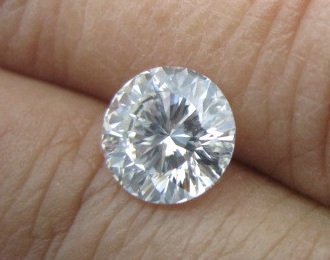
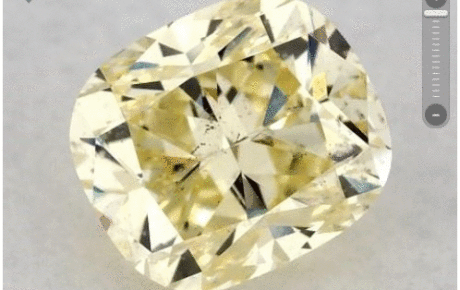


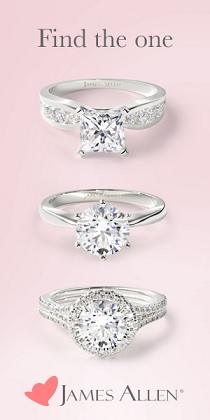









52 Comments
I need to replace a stone from an eternity ring. I was told I need a 4.1 mm round stone, S1-I1, g or j color. I was told that I need to find diamonds with similar table sizes so that they match. What would you recommend? Thank you.
Doing a proper replacement for a stone from an eternity ring is tricky. It is best to get your jeweler where you bought the diamond to do the the replacement. Basically, you need to match the table size and physical dimensions to the rest of the ring. Without looking at your ring, I can’t make a proper recommendation in this scenario.
Hey Paul… great site! I’ve been told that having a depth value less than table will result in a darker diamond. Is this true? Most other things being equal, would one choose a diamond with greater relative depth or table? I’m comparing two very similar stones, one D61.1/T57 (E) and another D58.5/T62 (F). Thanks!
(corrected)
The statement isn’t always true. It depends on a case by case basis.
From what I can tell, the F diamond isn’t going to perform well. The excessively large table size will result in a fisheye that would be easily observable with a little tilt.
That said, while the E diamond has decent looking proportions, it is by no means a basis to conclude that the stone is going to be well cut.
https://beyond4cs.com/buying-diamonds-blind/
https://beyond4cs.com/shapes/round/ideal-proportions/
Hello Paul,
I am in the process of buying a diamond and stumbled across your website. You have so much great information. Thanks for making it available for the rest of us.
I have found a diamond that I think is a good deal. After some reading on your site though, I am afraid that the diamond is cut too deep instead of having ideal diamond depth.
It is at 3.08ct (J). The table is 56 and the depth is 62.3. The cut grade is excellent however. Thoughts? Thanks in advance.
Sam
Actually, the table and depth looks fine to me. But there’s nothing else I can tell you much based on numbers alone.
https://beyond4cs.com/buying-diamonds-blind/
https://beyond4cs.com/shapes/round/ideal-proportions/
Hi Paul,
I came across these 2 diamonds on James Allen and was stumped by what I saw in the Idealscope images.
– jamesallen.com/diamonds/G-SI1-Ideal-Cut-Round-Diamond-1500331.asp
– jamesallen.com/diamonds/I-VS2-Ideal-Cut-Round-Diamond-1493120.asp
( Update: These 2 diamonds had been sold and removed from JA’s listing. )
First of all, I want to mention that I had read through your entire site on choosing a diamond. Great stuff. Good information. However, this particular phenomenon was not covered in your articles. Perhaps you did and I couldn’t find it. If that’s the case, could you point me in the correct URL.
Here’s my question: Why is the Idealscope image for the G SI1 diamond so weird looking? It has alot more blacks than the usual Hearts and Arrows I had seen on your website.
By comparison, I picked out an I VS2 and now, the idealscope image looks ‘normal’ to me.
Could you shed light on this? And theoretically, which diamond would be a better choice if I were to pick one?
Thanks,
Jon
Hi Jon,
Thanks for your question. I think you have a very observant eye. Not many people would have observed this when looking at diamond details. From the Idealscope, both diamonds are showing excellent optics with tons of reds and minimal whites.
For the G colored diamond, we see alot more areas of black which relates to more contrast in the diamond. This phenomenon occurs when the diamond has a depth % that is less than the table %. In this particular diamond, the depth is 58.4% and the table is 61.0%. Technically speaking, the difference is really due to a combination of star facet lengths, lower girdle facets, table size and depth proportions.
For the I colored diamond, the depth % is higher than the table %. This results in the kind of Idealscope images you will see in the reference chart for light performance.
Hope this helps,
Paul
Hi Paul,
Jon here again. Thanks for the super fast reply. I really appreciate it. Since the G colored diamond has more contrast, will this impact the brilliance of the stone?
If you were given a choice between these 2 diamonds, which would you pick and why?
Jon.
Dear Jon,
While it is true that the G colored diamond will be more contrasted than the I colored diamond, I believe that when both diamonds are placed side by side to each other, the difference in contrast will NOT be easy to detect. To the untrained eye, these 2 diamonds will appear similar to each other.
However, to the trained eye, you can probably pick up the scintillation patterning from the G colored diamond. That is caused by the additional black areas you see in the idealscope image. However, there is a tradeoff here. The fire and dispersion of this diamond might not be as high as that of the I colored stone.
Assuming that I would have to make a choice between these 2 diamonds, it is a balance between getting value for money versus cut quality. Strictly speaking, the I color diamond is better cut and has a better balance of fire vs brilliance.
Since I do value color, I would go for the G colored diamond and I say this with the caveat of my personal preference. In terms of face up size, the physical measurements are very close to what the I colored diamond offers. Also, there is only a price difference of about $150 between these 2 diamond. However, the G colored diamond is 2 grades better in color than the I colored stone.
This means that the G colored diamond will appear relatively whiter. To me, this is what most people would be able to observe when looking at your ring. The slightly higher price of $150 is justifiable for a 2 grade color jump.
Hope this helps,
Paul
Is it ever a good idea to purchase a diamond with a table width which is larger than the diamond’s depthnin regards to round diamonds. Thanks.
Depends on the diamond’s shape and what you are after. In general, no.
Hi Paul,
I have a jeweler that is trying to sell me this diamond for $3900:
BR 1.01 E SI2 EGLNY
Depth: 62.3
Table: 59
Culet: N
Girdle: TN-STK
Polish: G
Sym: G
Fluor: M
Cut: G
Is that a good price?
Run! Poorly cut diamond plus a scammy report from EGL is a sure fire way to get ripped off.
Hi Paul,
Thanks so much for the extremely helpful information for beginners like me.
Grateful if you may let me have your views on the following questions:
1. A shop is showing me diamonds and what they say are the GIA certificates of these diamonds. Is there any way I could verify that the diamond shown to me is indeed the diamond mentioned in the GIA certificate. Is the “Inscription(s): GIA 2228540824” relevant? If so, where can I find the inscription in the diamond?
2. I am convinced by you that cutting is the most important aspect. Is the cutting of the diamond GIA 2228540824 (1.20 carat, excellent cutting) brilliant by the numbers of the dimension of the diamond?
Thank you very much
1) https://beyond4cs.com/care-and-maintenance/how-to-avoid-diamond-switching/
2) https://beyond4cs.com/buying-diamonds-blind/
Hi Paul,
I am doing a report on diamonds and was given a data set with different buying factors. Among those factors are the depth and table (both as the proportions you describe). I know you want to be around 60, but what is the lowest ratio you can have for depth and table? For example, in our data set we have some observations that have the table of 6 or 126. For depth we have some numbers around 4, are these possible? The majority of our data is around 60, so we are thinking it is a user input error.
Thank you for your help,
Well, your data’s headings are definitely erroneous. There’s no way a table% can be more than 100%. For that matter, I also haven’t seen diamonds cut to table percentages of 6%.
Hi Paul,
Question: I’m trying to match .4 pointers to make four stone ring.
Diamonds sourced for me by seller are all GIA triple excellent (have seen certs):
.41 carat(4.74 x 4.76x 2.96) Table 58%, E,VS1
.42 carat (4.76 x 4.79x 3.01) table 56% E Si1
.41 carat (4.71×4.73×2.96) Table 57%, F, VS1
.41carat (4.75×4.77×2.94) Table 59%, F Si1
Do you think these would be good match for 4 stones? I’m a little concerned that the difference on table sizes is 3% or maybe that won’t matter on Diamonds this small when placed together. I’m (perhaps incorrectly) not that concerned about the colour and clarity differences as I feel they will not be noticeable and I have a budget to stick to. I am also assuming that the overall performance of the diamonds would be very good given that they are all certified GIA triple Ex. Any help appreciated.
Thanks
Mim
Color and clarity won’t matter. However, I can tell you that a couple of diamonds down there with table sizes larger than 57% will never make it pass my own standards if I am buying the ring for myself.
Can I figure out the depth percentage of a diamond from its measurements?
Yes you can. A simplistic way of doing this is to use the formula: (total depth ÷ avg. diameter) x 100%
Hi Paul,
Which is more important or how to rank the importance?
Table, Depth, Crown Angle,Pavilion Angle
I’ve been looking at several diamonds. Couldn’t make up my mind on based on the ideal proportions, most of them have crown angle at 35.5 but the rest is ok. It is safe to say crown angle 35.5 is ok?
Any proportions that are outside of my recommended ranges are instantly rejected: https://beyond4cs.com/shapes/round/ideal-proportions/
There are so many available stones to choose from and even if they meet the requirements and numbers here, that’s just the first step. I would follow up with asking for tangible cut data to analyze the diamond.
Hi Paul. I have lost the stone out of my engagement ring. after looking at diamonds at a local jeweler, we have ascertained it is an old cut diamond, as it was raised and not flat at the top, after looking at the brilliant cut ones which are flat.
Can you tell me what I should be looking for to get the similar diamond? Sorry for the ignorance. I have been offered a
0.73 carat old cut stone quality G/Vs1.
Carole
Sounds like you are in for a deal that gets you ripped off. Who graded the diamond as G/VS1? If it comes with a NON-GIA certificate, then that confirms it.
Hi Paul,
It is really eye opening to read the vast amount of unbias info you provide here. Thank you. (I only wish I had read this 15 years ago when I bought my first diamond ring!)
I have been offered a opportunity to buy a 1.22 carat tiffany diamond ring. (assuming T&C certificate is accurate)
F, VS1
From what I have read, only 2 criteria are out:
Polish: Very Good (Ideally excellent)
Table size%: 58% (Ideally 54% – 57%)
All other cut proportion parameters falls within your stricter range.
I know you said, any deviation, the stone should be rejected….
Here in Australia, I don’t know if we have as much choice as in US especially in the secondary market.
How would these two parameters affect the performance against a stone that is ideal?
Thank you.
It really depends on how the individual facets work together for light performance. When the proportions are right, the chances (probability) of that happening are better. The key is to look at tangible data like the ASET/Idealscope images.
https://beyond4cs.com/grading/aset-reference-charts/
And just to be clear, most people assume that Tiffany diamonds are top notch. They aren’t and you clearly see why here. If a jewelry business really cared about “best quality”, there’s no way they would allow the basic stuff like symmetry/polish to be second rate. They have a good brand name and that’s really all.
Thank you very much Paul,
I am so disillusioned.
Can I just give you all the info, if its a AVOID, I will never speak of it again…
1.22 carats F, VS1
Precision of cut: EX
Polish: VERY GOOD
Symmetry: EX
Total depth %: 61.6
Table size %: 58
Crown height %: 14.7
Crown Angle: 34.2
Star length % 50
Pavilion Depth % 43.6
Pavilion angle: 41.1
Lower half length %: 75%
Girdle thickness: Medium to slt thick
Like you mentioned, thought I can’t go wrong with a T&C…
I am also shocked to find another T&C 1.52carats D,IF ring priced 3 times as the one I m looking at failed all but 3 criteria out of the 12!
Prior to tonight, I have never heard of ASET/Idealscope images. May I ask can this be done once the diamond is already on the ring? (I am so intimidated by the so called “experts” here in OZ, I am surely going to be made to feel absolutely inadequate when I mention about this technology tomorrow! Lol).
This can be done on a mounted ring. Here’s an example: https://beyond4cs.com/reviews/blue-nile/signature-diamond/
With T&C, you don’t get the terrible diamonds like out in the market but you don’t get the great stuff either and the prices are steep.
These links will offer more info:
https://beyond4cs.com/reviews/tiffany/
https://beyond4cs.com/jewelry-guide/tiffany-setting-engagement-ring/
For what’s its worth, you actually don’t need to buy the scope as the better jewelers who are transparent offer them in their listings.
https://beyond4cs.com/best-place-to-buy-engagement-ring/
Hi Paul, I read the amazing stuff on your website, it’s beyond helpful. I’m highly considering purchasing a round 1.51ct stone which appears to be in my budget after several comparisons however I wanted some clarification from you if this should be a go or no go. GIA # 2277973358 Tripe Ex. G/SI1. Based on two ideal Diamond charts, including yours the Table is Very Good and the Depth is Excellent. The color is Medium. Depth 61.9, Table 59, CA 35.5, CH 14.5, PA 40.8, PD 43, Star Length 50%, Girdle Med – Sl Thick, Culet None. Keys are Twinning Wisps, Crystal, Feather, Cloud, Natural. I can only see the inclusions under the loop, it looks good under the natural daylight, I didn’t see any haze or oily looks. Would this be a good purchase for this diamond or I should run away? Any feedback you provide would be helpful.
There are plenty of well cut diamonds with proper proportions to choose from in the market. So, why settle on this mediocre stone? The large table size in combination with the crown and pavilion angles will create some issues with light performance.
Hi Paul,
I intend to buy a diamond for my wife. It’s price is very good. However, total depth is %57 and table width is %62. Crown angle 31,6 and Pavilion angle is 40,9. Girdle thin %2,0(which compensates for the shape I think). Culet is %0,8 natural. VG-VG-VG. G color, nil, VS1, 2,12 ct, round cut.
Stone is okey, sparkling enough but because of proportions of table width and depth we are unsure. Pavilion angle is good enough perhaps crown angle compensates for the unfit shape as well.
What do you think? Many thanks.
Good? That’s what most uneducated shoppers think. This is an absolute disaster of a poorly cut diamond and the extremely low crown angles can create durability issues. If you asked me, this is garbage tier quality and that probably explains the price. When shoppers think they gotten deals or “cheap purchases”, more often than not, they actually ended up overpaying for such diamonds.
Hi Paul,
Thank you for your very informative website.
Was wondering what you thought of this diamond GIA 1289104184.
It is a 1 carat G color VS2 with a very good cut grade.
The table is 54%, Depth 62.2%, crown angle 34.0, pavilion angle 40.8, lower girdle 75%, star facet 50%, girdle medium to slightly thick faceted 4.0% , crown height 15.5%, pavilion depth 43.0% and no cutlet. Polish is excellent with no fluorescence.
Measurements are 6.39 – 6.41 x 3.98mm
What l’m not too sure about is the symmetry as it is only good.
Your thoughts on this would be greatly appreciated.
Thanks.
The diamond is mediocrely cut. I won’t even waste time on garbage tier diamonds when there are literally hundreds of other well cut diamonds in the market. So, why settle for this?
Hi Paul,
Thank you for your reply.
Is this because the diamond is only graded a very good cut and the symmetry is only good?
I thought since this diamond was within the ideal proportions shown on your website that it was a pretty good diamond, except for symmetry.
Can you please explain this to me?
Thanks again,
Laraine
Proportions are only the first steps that I use to filter out poorly cut diamonds. For round brilliant stones, I generally use proportions AND Ex/Ex polish/symmetry ratings to narrow down the selections. Thereafter, I look at tangible data to make final selections.
The Very Good cut rating could be assigned by GIA due to the symmetry rating and/or issues with visual inspection when the gemologists evaluate the diamond for fire/brilliance/contrast patterning. If it were a Very Good symmetry grade and if tangible data shows a diamond with strong light return, then I might consider it to be a candidate for further evaluation before buying. However, the issues with a Good symmetry rating doesn’t bode well. It is likely that the outline of the diamond and contrast patterning is negatively affected because of symmetry issues.
The point is, there are so many diamonds out there that are going to be better cut. I see no reason why you would want to purposely choose a diamond with Good symmetry especially if you care about cut quality.
Great website! I’m looking at a round, D color, vvs2
The table is a little large @ 58.5%, which concerns me
Total depth is 61.4%
Crown angle is also slightly large 36%, but the Pavilion angle is 40.6%
Excellent polish and symmetry, medium faceted girdle
Given all the proportions, Should I be concerned with the light performance in any way the larger table and do you have any other thing to add about?
Thanks
You should be concerned. The table is too big and the crown angles are too high. It affects light return and the balance of brilliance/fire. There are plenty of well cut diamonds in the market and there’s no reason why you should settle for a mediocre stone. If you shop at the right places, it is going to make your shopping experience more enjoyable and safer.
Hi Paul, love the content, I now know so much about diamonds and their cuts!
Can you give me some advice for my search? I’m looking for a lab made diamond around 1-1.5 carats, with the best possible hearts and arrows cut I can get.
I just purchased an ASET scope and I’m waiting for it to come in.
I’m looking to buy a loose diamond online, ideally, I want to screen a few diamonds and buy one that looks ideal from the certificate info and pictures. And then look at it under the ASET to determine if I want to keep it or return it and try again.
Here are a few diamonds I have looked at and that I think may be a contender for what I’m looking for. I have not requested the certificates for these yet, but I intend to only purchase if they fall within your cut guidelines.
https://www.jamesallen.com/loose-diamonds/round-cut/1.01-carat-e-color-vs2-clarity-excellent-cut-sku-7435152
https://www.jamesallen.com/loose-diamonds/round-cut/1.07-carat-f-color-vs2-clarity-ideal-cut-sku-7409423
https://www.jamesallen.com/loose-diamonds/round-cut/1.09-carat-f-color-vs2-clarity-ideal-cut-sku-7735729
Those are just a few examples of ones I’m looking at. I’m going to look at the stats on the certificate before I buy them to make sure the %’s are good. Then when I receive the diamond, I’ll look at them under the ASET and decide if I want to keep it.
Let me know if the ones I linked may be contenders to be an ideal H&A diamonds. If not, I’d love to hear why you don’t think those diamond would qualify based on the images.
Thanks!
I reviewed all 3 diamonds and they are all well cut. Clearly, you know what you are doing. And for lab created diamonds, they are rarely well cut but yet, you managed to find 3! Good job!
Out of the 3 diamonds, this diamond is the best cut of them all in terms of cut precision. This would be my 2nd choice.
If you expect lab created diamonds to be ideal H&A diamonds, you will be sorely disappointed. Lab created diamonds aren’t polished to these types of standards because of costing.
If you want the best of the best in cut quality and a super ideal cut diamond, you should head over to White Flash or Brian Gavin. JA also offers their collection of H&A diamonds within their Truehearts selection.
I would say this, the 2 lab diamonds above are as good as Lab created diamonds will be cut to. So, if you are in the market for a lab created diamond, forget about true H&A diamonds. They only exist in the natural diamond market segment. Go for either of the diamonds above. Both are winners that I would personally buy. So, that says a lot.
How would you measure the depth of a diamond while mounted in a setting that limits your ability to reach the culet?
You can’t do it accurately if it is mounted. However, you can estimate it using a millimeter gauge depending on the setting and experience you have in handling diamonds.
Hi Paul,
I’m wondering – if the GIA gives a round cut diamond a cut grade of excellent, but the table and depth are outside the recommended ranges you’ve listed, how can it still be considered excellent cut?
Which is more important – the excellent stamp from GIA or the table and depth measurements?
For more detail, the measurements are:
Table: 58%
Depth: 62.9%
Crown: 33.5%
Slightly thick faceted
The table and depth are both outside the recommended ranges, but it is still EX EX EX from GIA.
Thank you!
The categorization of GIA’s excellent cut is very broad and lenient. Most of the diamonds within the GIA triple excellent range have decent light performance but if you are looking for truly spectacular diamonds, these are very rare and few.
Read: https://beyond4cs.com/truth-about-gia-triple-excellent-diamonds/
Hi Paul,
I’ve been doing some research for several weeks about the best combinations for the best possible stone within my budget. Thank you so much for your extensive research in the subject.
I hope now to present my findings as a sort of “test” of what I learned.
Could you sample these three stones and let me know if my reasoning is valid? Either way, I truly appreciate your input.
https://www.jamesallen.com/loose-diamonds/round-cut/0.72-carat-f-color-vvs2-clarity-true-hearts-cut-sku-11270573
https://www.jamesallen.com/loose-diamonds/round-cut/1.02-carat-e-color-vs2-clarity-true-hearts-cut-sku-11707457
https://www.jamesallen.com/loose-diamonds/round-cut/0.72-carat-e-color-vvs1-clarity-ideal-cut-sku-9535733
All 3 of them fall within your recommended ranges, except for the third, which has a shallow depth. This shows on its picture as it is darker than the rest.
Of the 3 I am partial to the first as its points and arrows seem well defined, while the third one is third in my ranking. Is my reasoning and ranking valid or did I make a mistake in saying “0.72-F” is the best?
Truly appreciate your help. Thank you!
I looked at all 3 diamonds and they are well cut diamonds. The True Hearts series for lab diamonds are better cut and they had been curated for light performance and cut precision. Cut wise, the 0.72 F VVS2 is on par with the 1.02 E VS2. Both of these are purchase worthy and I do like the 1.02ct diamond more because it hits the one carat mark and the VS2 clarity combination means that you get better value for money without having to pay a VVS premium to get an eyeclean stone.
Hi Professor Paul,
Is it a FL diamond after setting to a ring will become not FL anymore? The FL will only exist when it is a loose diamond before any setting?
Thank you for all your valuable knowledges provided in your web site.
You are correct. Technically speaking, FL diamonds only exist in the loose diamond form. Once it is set, it may no longer be classified as a “flawless” diamond because the setting process itself can introduce flaws to the stone. Because a flawless clarity rating can no longer be guarantee once it is set, a flawless diamond is automatically downgraded to an IF after it is mounted. I know this sounds “dumb” but this guideline is actually “set” by the industry.
I am new to all of this and find it all so confusing and scary. I am a 74 year old woman buying her very first diamond. A jeweler has a round brilliant diamond, .85 carat,color D, clarity S1, Cut good. The table! is .65%, measurements 5.92-6.01-3.74mm, cutlet VSM, TD 62.7%,,CA 35.0″, ST 55%, LH 85%,, PA 42.0″, Polish good, symmetry very good. His price is $2500…he says that is wholesale. I became suspicious when he became VERY PUSHY… I WAS STLL THERE BECAUSE HE DOES HAVE THE RING THAT I WANT TO PUT IT IN. Can you help me?
The diamond is in the junk tier cut quality standards. Wholesale prices? Nah… Wholesale prices don’t exist for the retail client. The definition of wholesale is to buy in bulk and you are doing exactly what a retail customer does. That is to buy a single stone. You are buying at a retail level and at a retail pricing. $2,500 for a piece of garbage is expensive.